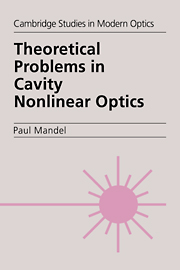Book contents
- Frontmatter
- Contents
- Introduction
- 1 Reduction of the Maxwell–Schrödinger equations
- 2 Parameter swept across a steady bifurcation I
- 3 Parameter swept across a steady bifurcation II
- 4 Optical bistability: Constant input
- 5 Optical bistability: Variable input
- 6 Multimode optical bistability
- 7 Free-running multimode lasers
- 8 Antiphase dynamics
- 9 Laser stability
- 10 Second harmonic generation
- 11 Saturable absorbers
- 12 Transverse effects in optical bistability
- Index
11 - Saturable absorbers
Published online by Cambridge University Press: 16 October 2009
- Frontmatter
- Contents
- Introduction
- 1 Reduction of the Maxwell–Schrödinger equations
- 2 Parameter swept across a steady bifurcation I
- 3 Parameter swept across a steady bifurcation II
- 4 Optical bistability: Constant input
- 5 Optical bistability: Variable input
- 6 Multimode optical bistability
- 7 Free-running multimode lasers
- 8 Antiphase dynamics
- 9 Laser stability
- 10 Second harmonic generation
- 11 Saturable absorbers
- 12 Transverse effects in optical bistability
- Index
Summary
Introduction
Until now, we have always assumed that the cavity losses are linear, that is, field-independent. This need not always be true, and in this chapter we investigate how nonlinear losses affect the operation of a nonlinear optical device. We consider two examples. The first one is the laser with a saturable absorber, the second is parametric amplification in the presence of a saturable absorber.
The modeling of lasers with a saturable absorber (LSA) has a history that is practically as long as that of the laser. Problems related to the LSA are still a subject of debate. An LSA is a laser that contains both an active (or amplifying) medium and a passive (or absorbing) medium. For instance, if population excitation is produced in the laser cavity but inversion is not achieved in the whole cavity, some domains of the laser amplify the radiation and others absorb it. The salient feature of this situation is that both amplification and absorption result from the resonant interaction of light with atoms. Hence, both processes contribute to the nonlinear response. One way to look at an LSA is to consider it as a generalization of a laser in which the losses are as nonlinear (i.e., intensity-dependent) as the gain. From the viewpoint of dynamical systems, the LSA is a prototype of competition between nonlinear gain and nonlinear losses. As a result, there has been over the years an irresistible temptation to attribute to saturable absorption properties that are not explained by the standard laser equations, derived in Chapter 1.
- Type
- Chapter
- Information
- Theoretical Problems in Cavity Nonlinear Optics , pp. 140 - 159Publisher: Cambridge University PressPrint publication year: 1997



